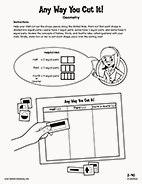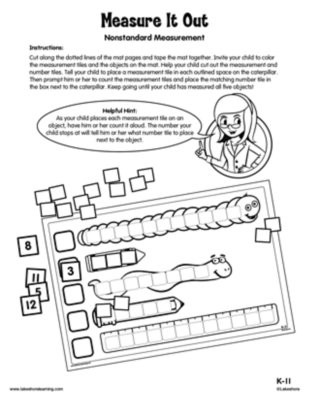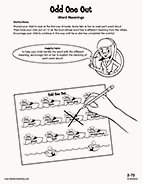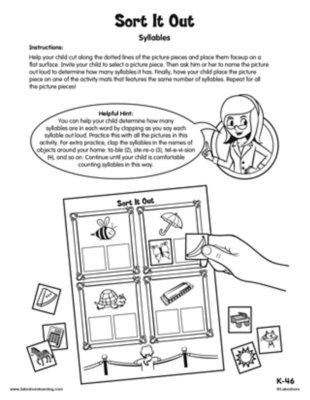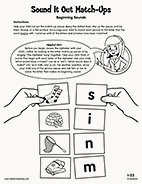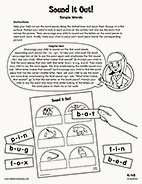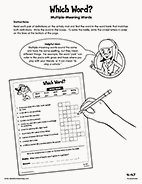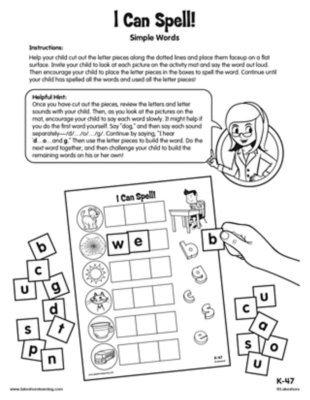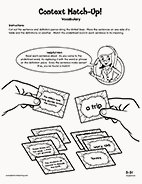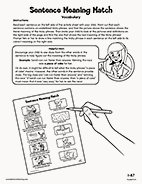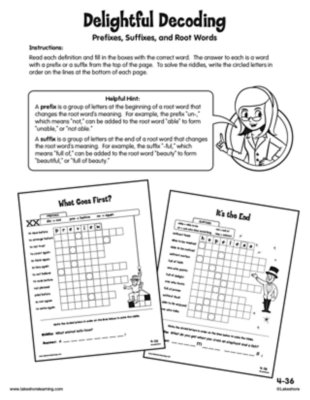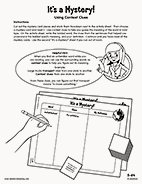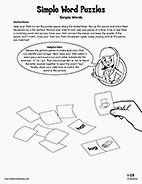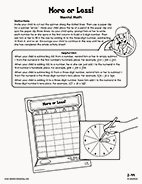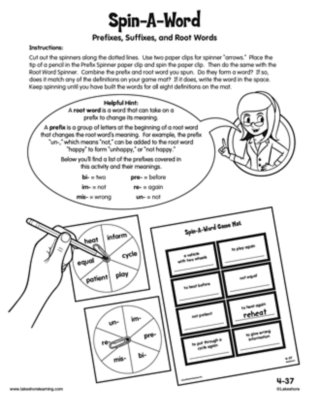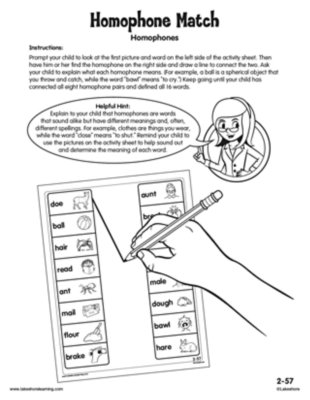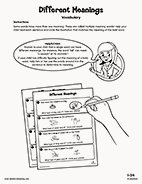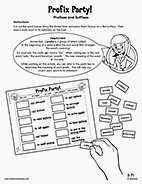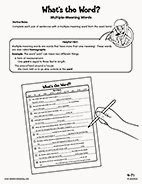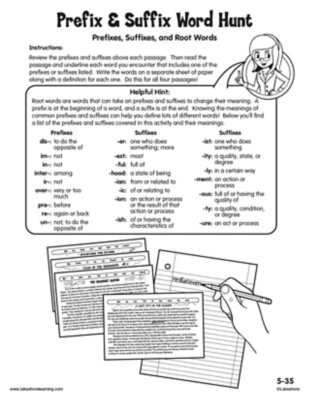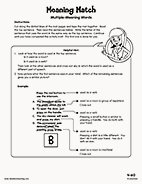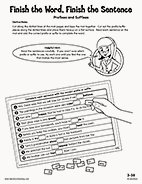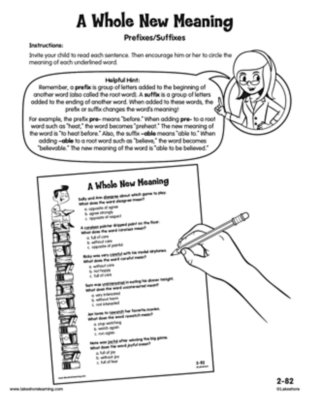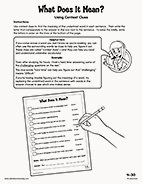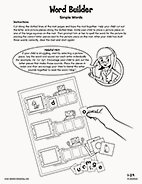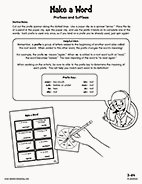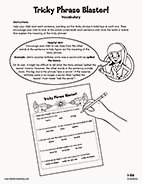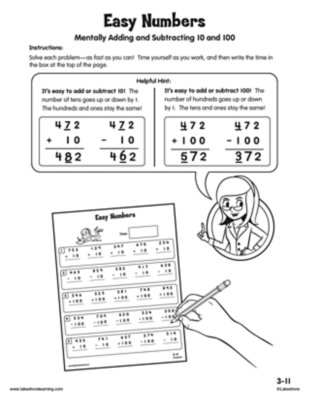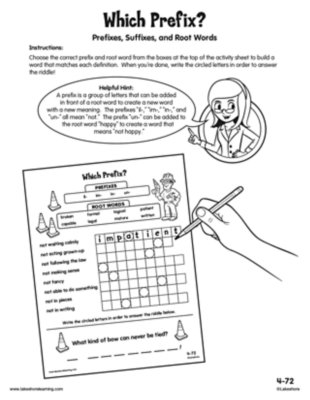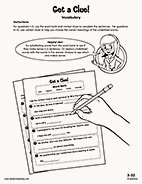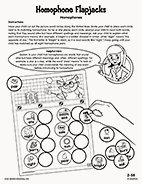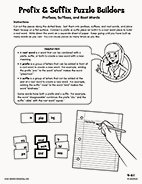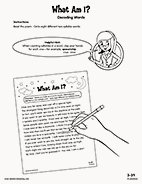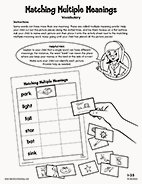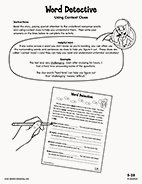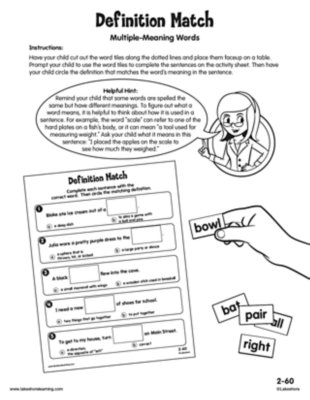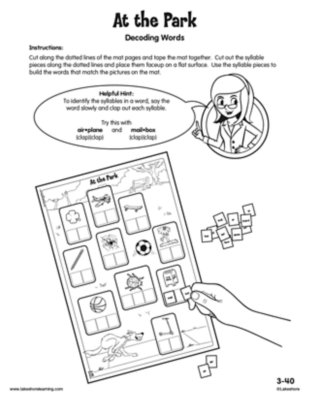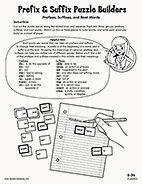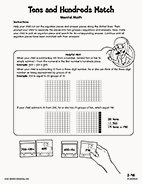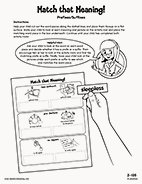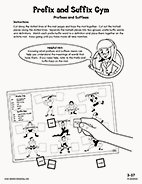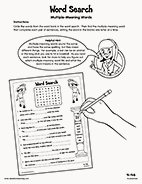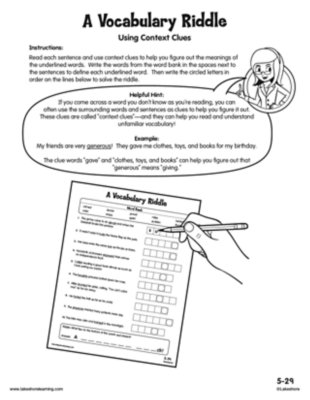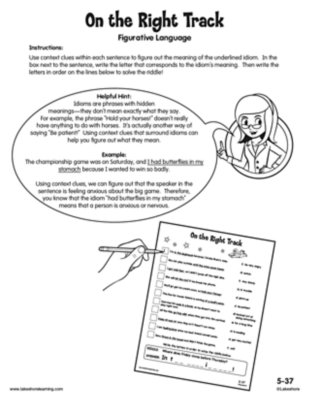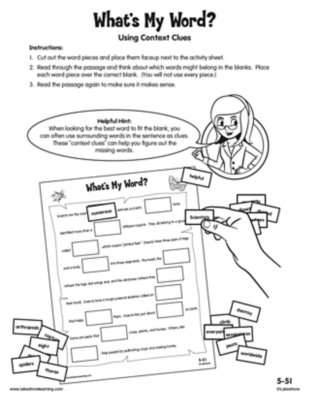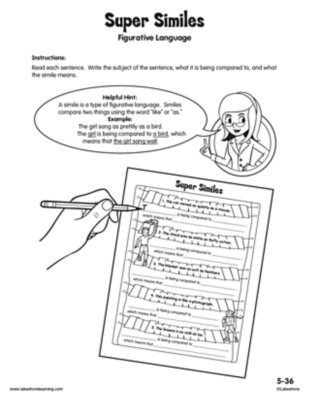Narrow by Grade
Grade
49 results for "brights 4 ever cut outs"
During second grade, your child will learn to recognize shapes and identify their attributes, such as how many sides, angles or vertices (corners) they have. Your child will also learn to divide circles and rectangles into halves, thirds and fourths.
View worksheetWhen entering kindergarten, your child should be able to identify how long something is by measuring it with like objects instead of a ruler. This is called nonstandard units of measurement. For example, “The dolphin is nine fish long.”
View worksheetDuring second grade, your child will learn to determine the meanings of grade-appropriate words based on the context in which they are used.
View worksheetDuring kindergarten, your child will learn to count and say the syllables in spoken words. For example, your child should understand that “kitten” has two syllables: kit•ten.
View worksheetWhen entering first grade, your child should be able to identify the beginning and ending sounds in simple words, such as identifying the “b” sound in “bat” or the “n” sound in “pen.”
View worksheetDuring kindergarten, your child will learn to spell simple words by sounding them out, such as “c-a-t” and “f-o-x.”
View worksheetWhen entering fourth grade, your child should be able to figure out the correct meanings of multiple-meaning words that appear in third-grade texts, such as knowing when the word “shower” refers to a rainstorm or a place to wash off.
View worksheetDuring kindergarten, your child will learn to spell simple words by sounding them out, such as “c-a-t” and “f-o-x.”
View worksheetWhen entering third grade, your child should be able to figure out the meanings of unknown words using a variety of strategies, such as looking at the context in which the word is used or consulting a dictionary.
View worksheetDuring first grade, your child will learn to figure out the meanings of new words and multiple-meaning words based on the context in which they are used.
View worksheetWhen entering fourth grade, your child should be able to figure out the meaning of a word when a prefix or suffix is added to a familiar root word, such as figuring out what the word “unhappy” means based on the knowledge that “un-” means “not.”
View worksheetWhen entering second grade, your child should be able to figure out the correct meanings of multiple-meaning words, such as knowing when the word “bat” refers to a baseball bat or a flying animal.
View worksheetDuring fifth grade, your child will learn to figure out the meaning of an unfamiliar word or phrase by using clues in the text, such as cause/effect relationships and comparisons. For example, in the following sentence, you can determine that the word “chastened” means “punished” by looking at the cause and effect: “When Judy found out that her son had cheated, she chastened him by taking away his video games.”
View worksheetWhen entering first grade, your child should be able to spell simple words by sounding them out, such as “c-a-t” and “f-o-x.”
View worksheetDuring second grade, your child will learn to mentally subtract multiples of 10 from three-digit numbers without having to write down the problems and work them out. For example, 800 — 10 = 790.
View worksheetWhen entering third grade, your child should be able to mentally add 10 or 100 to any given number from 100 to 900 without having to write down the problems and work them out. For example, 156 + 10 = 166 and 234 + 100 = 334.
View worksheetWhen entering fourth grade, your child should be able to figure out the meaning of a word when a prefix or suffix is added to a familiar root word, such as figuring out what the word “unhappy” means based on the knowledge that “un-” means “not.”
View worksheetWhen entering second grade, your child should be able to figure out the correct meanings of grade-appropriate homophones—words that sound the same but have different meaningss. For example, “to” and “two” or “eye” and “I.”
View worksheetWhen entering first grade, your child should be able to figure out the meanings of unfamiliar words and multiple-meanings words that they encounter in kindergarten-level texts.
View worksheetDuring third grade, your child will learn to figure out the meaning of a new word when a prefix or suffix is added to a familiar word, such as figuring out the meaning of “preheat” based on the knowledge that “pre-” means “before.”
View worksheetDuring fourth grade, your child will be asked to figure out the correct meanings of multiple-meaning words that appear in fourth-grade texts, such as knowing when the word “pitcher” refers to a container for pouring liquids or a person throwing a ball.
View worksheetWhen entering fifth grade, your child should be able to use common, grade-appropriate Greek and Latin prefixes, suffixes and roots to figure out the meaning of a word. For example, “telegraph,” “photograph” and “autograph” all contain the Greek root “graph,” which refers to something that is written or drawn.
View worksheetDuring fourth grade, your child will be asked to figure out the correct meanings of multiple-meaning words that appear in fourth-grade texts, such as knowing when the word “pitcher” refers to a container for pouring liquids or a person throwing a ball.
View worksheetWhen entering third grade, your child should be able to figure out the meaning of a new word when a prefix or suffix is added to a familiar word, such as figuring out the meaning of “unhappy” based on knowledge of the word “happy.”
View worksheetDuring second grade, your child will learn to figure out the meaning of a word when a prefix or suffix is added to a familiar root word, such as figuring out the meaning of “unhappy” based on the knowledge that “un-” means “not.”
View worksheetWhen entering fourth grade, your child should be able to use clues within a sentence to figure out the meaning of an unfamiliar word or phrase. For example, in the following sentence, the underlined portion provides a clue to what the word “aviary” means: The zoo’s aviary was filled with owls, bluebirds, parrots, parakeets and cuckoos.
View worksheetWhen entering first grade, your child should be able to spell simple words by sounding them out, such as “c-a-t” and “f-o-x.”
View worksheetDuring third grade, your child will learn to figure out the meaning of a new word when a prefix or suffix is added to a familiar word, such as figuring out the meaning of “preheat” based on the knowledge that “pre-” means “before.”
View worksheetDuring first grade, your child will learn to figure out the meanings of new words and multiple-meaning words based on the context in which they are used.
View worksheetWhen entering third grade, your child should be able to mentally add 10 or 100 to any given number from 100 to 900 without having to write down the problems and work them out. For example, 156 + 10 = 166 and 234 + 100 = 334.
View worksheetDuring fourth grade, your child will learn to use common, grade-appropriate Greek and Latin prefixes, suffixes and roots to figure out the meaning of a word. For example, “telegraph,” “photograph” and “autograph” all contain the Greek root “graph,” which refers to something that is written or drawn.
View worksheetWhen entering third grade, your child should be able to figure out the meanings of unknown words using a variety of strategies, such as looking at the context in which the word is used or consulting a dictionary.
View worksheetWhen entering second grade, your child should be able to figure out the correct meanings of grade-appropriate homophones—words that sound the same but have different meaningss. For example, “to” and “two” or “eye” and “I.”
View worksheetDuring fourth grade, your child will learn to use common, grade-appropriate Greek and Latin prefixes, suffixes and roots to figure out the meaning of a word. For example, “telegraph,” “photograph” and “autograph” all contain the Greek root “graph,” which refers to something that is written or drawn.
View worksheetWhen entering third grade, your child should be able to decode—or read and understand—two-syllable words by applying word analysis skills and by sounding out words.
View worksheetWhen entering first grade, your child should be able to figure out the meanings of unfamiliar words and multiple-meanings words that they encounter in kindergarten-level texts.
View worksheetWhen entering fourth grade, your child should be able to use clues within a sentence to figure out the meaning of an unfamiliar word or phrase. For example, in the following sentence, the underlined portion provides a clue to what the word “aviary” means: The zoo’s aviary was filled with owls, bluebirds, parrots, parakeets and cuckoos.
View worksheetWhen entering fifth grade, your child should be able to figure out the meaning of an unfamiliar word or phrase by using clues in the text, such as definitions or examples.
View worksheetWhen entering second grade, your child should be able to figure out the correct meanings of multiple-meaning words, such as knowing when the word “bat” refers to a baseball bat or a flying animal.
View worksheetWhen entering third grade, your child should be able to decode—or read and understand—two-syllable words by applying word analysis skills and by sounding out words.
View worksheetWhen entering fifth grade, your child should be able to use common, grade-appropriate Greek and Latin prefixes, suffixes and roots to figure out the meaning of a word. For example, “telegraph,” “photograph” and “autograph” all contain the Greek root “graph,” which refers to something that is written or drawn.
View worksheetDuring second grade, your child will learn to mentally subtract multiples of 10 from three-digit numbers without having to write down the problems and work them out. For example, 800 — 10 = 790.
View worksheetDuring second grade, your child will learn to figure out the meaning of a word when a prefix or suffix is added to a familiar root word, such as figuring out the meaning of “unhappy” based on the knowledge that “un-” means “not.”
View worksheetWhen entering third grade, your child should be able to figure out the meaning of a new word when a prefix or suffix is added to a familiar word, such as figuring out the meaning of “unhappy” based on knowledge of the word “happy.”
View worksheetWhen entering fourth grade, your child should be able to figure out the correct meanings of multiple-meaning words that appear in third-grade texts, such as knowing when the word “shower” refers to a rainstorm or a place to wash off.
View worksheetWhen entering fifth grade, your child should be able to figure out the meaning of an unfamiliar word or phrase by using clues in the text, such as definitions or examples.
View worksheetWhen entering fifth grade, your child should be able to figure out the meaning of figurative language, including similes, metaphors and idioms.
View worksheetDuring fifth grade, your child will learn to figure out the meaning of an unfamiliar word or phrase by using clues in the text, such as cause/effect relationships and comparisons. For example, in the following sentence, you can determine that the word “chastened” means “punished” by looking at the cause and effect: “When Judy found out that her son had cheated, she chastened him by taking away his video games.”
View worksheetWhen entering fifth grade, your child should be able to figure out the meaning of figurative language, including similes, metaphors and idioms.
View worksheet